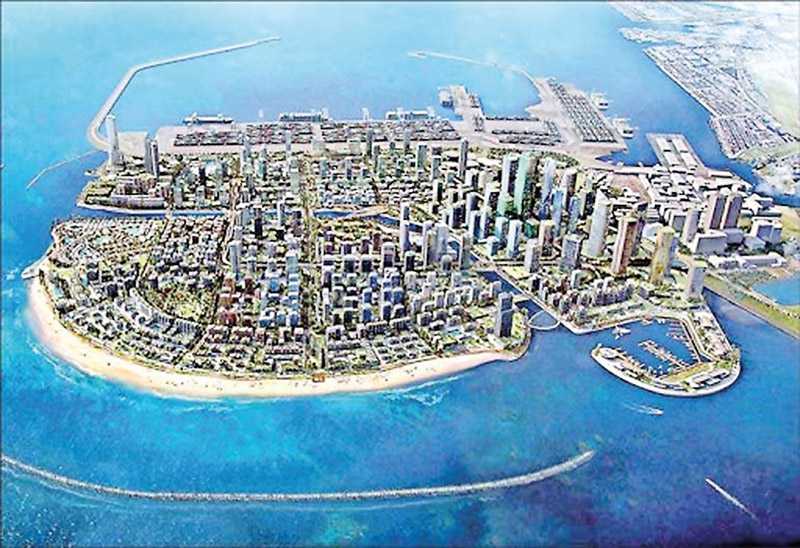Saturday Dec 13, 2025
Saturday Dec 13, 2025
Monday, 17 May 2021 00:00 - - {{hitsCtrl.values.hits}}

We need to put the entire Colombo Port City project in the footing of a commercial venture with no special laws other than laws to facilitate internationally legitimate private investments
By Hema Senanayake
Chinese economic wisdom and theory work here. Prior to the year 2013, China believed in Western economic theory on economic development. That is to increase exports and to expand the domestic market. Under this economic philosophy development of infrastructure can either be intermediate goods in which investment is justified by final output or the increased wellbeing of citizens or both.
If I cite an example close to our readers Mahaweli Development project is a large infrastructure project in which investment is justified by increased crop production and electricity used by enterprises to produce goods and services. It also contributes to increased wellbeing of the people in many parts of the country. This kind of infrastructure development is something we can understand.
But in 2013 China significantly deviated from this understanding. This was a time that Western economies and Japan were reporting continued low economic growth or near stagnation and it also was a time that China’s economic growth was slowing down. China wanted to change it. So, they invented a new economic theory. They said that long-term economic growth can be achieved only by the development of infrastructural assets, such as roads, highways, high-speed rail lines, seaports, airports, G5 digital connectivity within China and in neighbouring countries in the region. Colombo Port City project originates from this Chinese version.
Unfortunately, this theory will not work in the long-term for China and is not something we can copy for Sri Lanka, because this is not how the capitalist economic system works. Just three years later, to be exact in 2016, a renowned American economist said that developed economies (like the United States) cannot achieve significant economic growth without creating ‘unsustainable financial conditions’, and if we do not do it, there will be long-term (or secular) stagnation. This idea is now known as ‘secular stagnation hypothesis’ of Summers.
This is an economic truth, and this is how economy works and when China shows some maturity with near full employment it has to face the same situation. Already China’s total systemic debt to GDP has exceeded the same figure of the United States by the year 2019, prior to pandemic. It is now second to Japan in terms of total debt to GDP. Total systemic debt includes public debt, household debt and non-financial corporate debt.
However, armed with Chinese new economic wisdom, in 2013, President Xi Jinping during an official visit to Kazakhstan, announced the infrastructural initiative of overland Silk Road Economic Belt. This project includes creating a vast network of high-speed railways, energy pipelines, highways, and streamlined border crossings, both westward—through the mountainous former Soviet republics—and southward, to Pakistan, India, and the rest of Southeast Asia. China expects that such a network would expand the international use of Chinese currency, the renminbi, as President Xi says, it will “break the bottleneck in Asian connectivity.” This is a topic for another essay.
However, in the same year (2013) President Xi announced the initiative of Maritime Silk Road during a visit to Indonesia. It accommodates expanding maritime trade traffic, China would invest in port development along the Indian Ocean, from Southeast Asia all the way to East Africa and parts of Europe.
Eventually both initiatives came to be known as Belt and Road Initiative (BRI). The project is to complete by 2049 to mark the establishment of the People’s Republic of China 100 years ago. According to some estimates the total investments made by China and other participating countries would be eight trillion dollars. Yet, all participating countries do not have foreign exchange reserve surpluses like China does. They need to borrow, and China will facilitate for it.
If those countries cannot justify those investments by the increased sellable output, BRI will be a debt trap for those countries. Think of what happened to Hambantota Harbour, now we do not have debt but for another 99 years Sri Lanka does not own it. This is just a precursor of what will unfold with the implementation of BRI for many participating countries. Having this in mind we need to make the best out of this Colombo Port City project because we cannot do away with it now. In the short to medium term, it will not change the country’s current account or the country’s financial account positively. In other words, the project will not bring debt-free dollars to support our Balance of Payment, in short to medium term.
The next thing we need to understand is that Chinese economic wisdom is in error. Infrastructural assets will not do any good, if the investment is not justified by increased sellable final output and increased wellbeing of the people. Therefore, we need to put the entire Colombo Port City project in the footing of a commercial venture with no special laws other than laws to facilitate internationally legitimate private investments. Private investments bring in revenue and sometimes create the most essential infrastructure for any country. For example, while China is looking for a total investment of $ 8 trillion in BRI until 2049, private investments in western economies will create new infrastructure, production and service facilities possibly exceeding $ 30 trillion in medium term triggered by technological innovation. This is how they try to avoid the secular stagnation. Vision makes a significant difference. So is for Sri Lanka but we lack it.
(The writer could be reached via [email protected].)